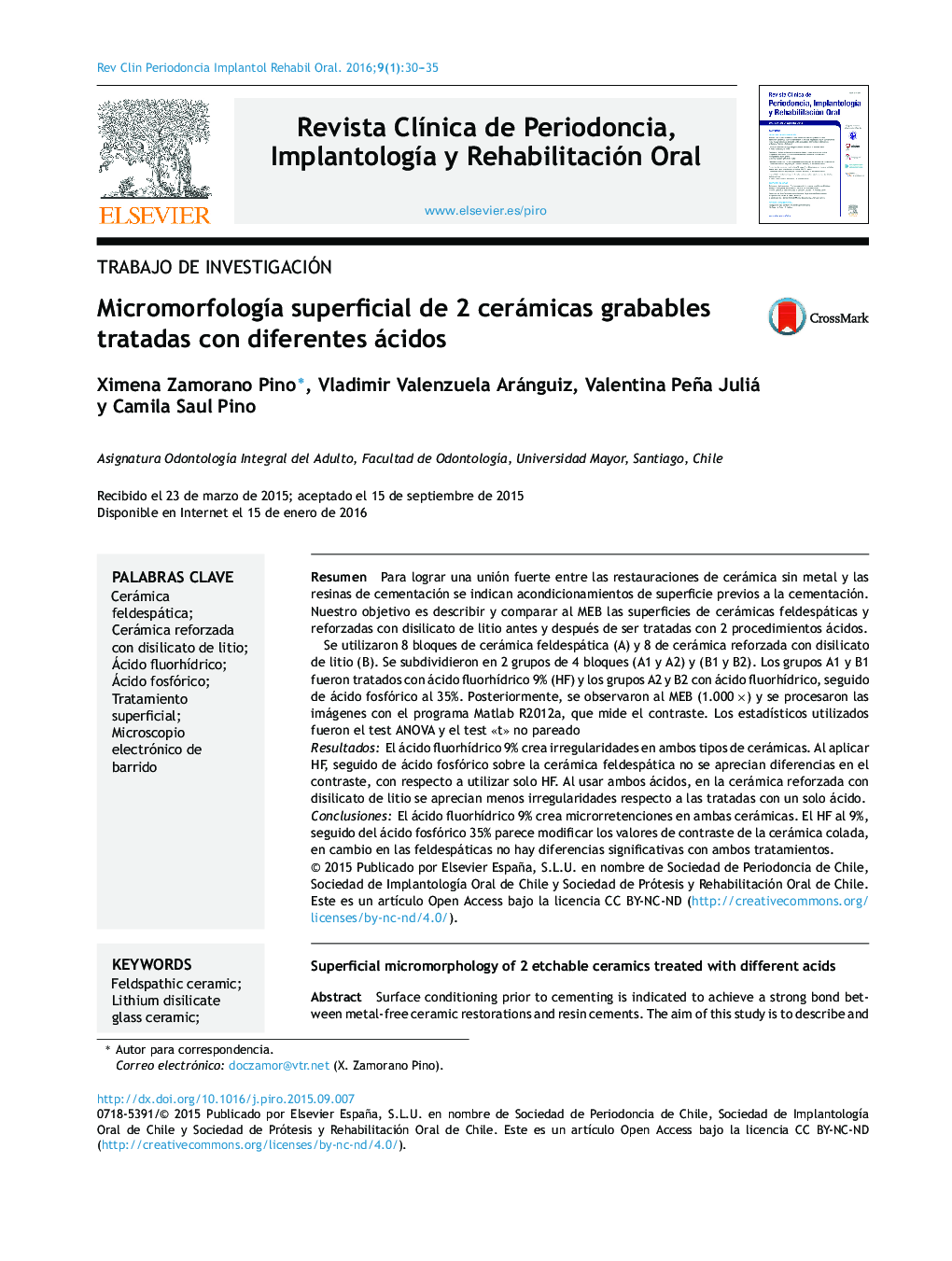| کد مقاله | کد نشریه | سال انتشار | مقاله انگلیسی | نسخه تمام متن |
|---|---|---|---|---|
| 3172330 | 1199934 | 2016 | 6 صفحه PDF | دانلود رایگان |
ResumenPara lograr una unión fuerte entre las restauraciones de cerámica sin metal y las resinas de cementación se indican acondicionamientos de superficie previos a la cementación. Nuestro objetivo es describir y comparar al MEB las superficies de cerámicas feldespáticas y reforzadas con disilicato de litio antes y después de ser tratadas con 2 procedimientos ácidos.Se utilizaron 8 bloques de cerámica feldespática (A) y 8 de cerámica reforzada con disilicato de litio (B). Se subdividieron en 2 grupos de 4 bloques (A1 y A2) y (B1 y B2). Los grupos A1 y B1 fueron tratados con ácido fluorhídrico 9% (HF) y los grupos A2 y B2 con ácido fluorhídrico, seguido de ácido fosfórico al 35%. Posteriormente, se observaron al MEB (1.000 ×) y se procesaron las imágenes con el programa Matlab R2012a, que mide el contraste. Los estadísticos utilizados fueron el test ANOVA y el test «t» no pareadoResultadosEl ácido fluorhídrico 9% crea irregularidades en ambos tipos de cerámicas. Al aplicar HF, seguido de ácido fosfórico sobre la cerámica feldespática no se aprecian diferencias en el contraste, con respecto a utilizar solo HF. Al usar ambos ácidos, en la cerámica reforzada con disilicato de litio se aprecian menos irregularidades respecto a las tratadas con un solo ácido.ConclusionesEl ácido fluorhídrico 9% crea microrretenciones en ambas cerámicas. El HF al 9%, seguido del ácido fosfórico 35% parece modificar los valores de contraste de la cerámica colada, en cambio en las feldespáticas no hay diferencias significativas con ambos tratamientos.
Surface conditioning prior to cementing is indicated to achieve a strong bond between metal-free ceramic restorations and resin cements. The aim of this study is to describe and compare the scanning electron microscopy (SEM) images of the surfaces of Feldspathic ceramic and Lithium disilicate glass ceramic before and after being treated with two acid procedures. For this, 8 blocks of Feldspathic ceramic (A) and 8 of Ceramic lithium disilicate (B) were used. They were subdivided into two groups of 4 blocks (A1 and A2) and (B1 and B2). Groups A1 and B1 were treated with 9% Hydrofluoric Acid (HF) and the A2 and B2 groups, with 9% Hydrofluoric Acid followed by 35% Phosphoric Acid. Subsequently, they were observed using SEM (1,000 ×) and the images processed with the program Matlab R2012a, which measures the contrast. The statistics used were ANOVA test and the unpaired t test.Results9% Hydrofluoric Acid creates irregularities in both types of ceramics. When applying HF followed by Phosphoric Acid on Feldspathic ceramics, no differences in contrast were found, compared to using only HF. With ceramic lithium disilicate using both acids, there are fewer irregularities with respect to those treated with a single acid.Conclusion9% Hydrofluoric Acid creates micro-retentions in both ceramics. 9% HF followed by 35% Phosphoric Acid appears to significantly modify the Lithium disilicate glass ceramic contrast values. On the other hand, the Feldspathic ceramic showed no significant differences with both treatments.
Journal: Revista Clínica de Periodoncia, Implantología y Rehabilitación Oral - Volume 9, Issue 1, April 2016, Pages 30–35
